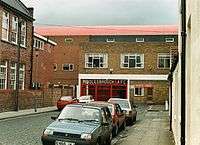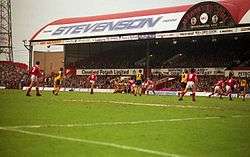Ayresome Park
|
Middlesbrough playing at Ayresome Park in 1991 | |
| Full name | Ayresome Park |
|---|---|
| Location | Ayresome Park Road, Middlesbrough, England |
| Coordinates | 54°33′51″N 1°14′49″W / 54.56417°N 1.24694°WCoordinates: 54°33′51″N 1°14′49″W / 54.56417°N 1.24694°W |
| Owner | Middlesbrough F.C. |
| Operator | Middlesbrough F.C. |
| Capacity | 26,667[1] |
| Field size | 110 x 74 yards |
| Surface | Grass |
| Construction | |
| Opened | 1903 |
| Closed | 1995 |
| Demolished | 1997 |
| Architect | Archibald Leitch[2] |
| Tenants | |
| Middlesbrough F.C. (1903–1995) | |

Ayresome Park was a football stadium in the town of Middlesbrough, North East England, and was the home of Middlesbrough F.C. from its construction in time for the 1903–04 season, until the Riverside Stadium opened in 1995.
History
Middlesbrough had previously played at Linthorpe Road West cricket ground, but election to the Football League meant that an improved stadium was required. Ayresome Park was built at Paradise Field, adjacent to the old Paradise Ground of Middlesbrough Ironopolis, who had played in the Football League in the 1893–94 season. [3]
The highest attendance at the ground (53,802) was set on 27 December 1949, when Middlesbrough played their North East rivals Newcastle United. Ayresome Park was also one of the venues for the 1966 FIFA World Cup. Three games were played at the ground, involving the Soviet Union, North Korea, Italy and Chile. North Korea famously beat Italy 1–0 at the ground, to knock out of the World Cup one of the most powerful footballing nations, and advancing the Koreans to the quarter-finals in the process. However, the attendances at Ayresome Park were among the lowest in the entire tournament, with a low of 15,887 fans at the game for North Korea versus Chile.
Middlesbrough famously had to play their first home game of the 1986–87 season – their first game as a Football League Third Division side – at Hartlepool because they were locked out of Ayresome Park by the bailiffs due to huge debts which almost put the club out of business. However, they were soon back at Ayresome Park after a takeover deal saved the club.
Despite this crisis, a £1.2 million sports centre was opened at the stadium on 3 March 1986 after a six-year delay caused by fire and safety regulations.
By the early 1990s, the stadium showing its age and clearly in need of major work to bring it up to date, and the demands of the Taylor Report meant that all stadiums in the highest two divisions of English football had to be all-seater by the start of the 1994–95 season. The surrounding residential area limited scope for expansion to an all seater capacity of no more than 20,000, and with the club wanting a considerably bigger capacity, the decision was made to build a stadium at a different location.[4]
Plans for a new 30,000-seat stadium on the banks of the River Tees were given the go-ahead in the spring of 1994, and construction work began that autumn, with the new stadium being ready for the 1995–96 season; when it became the biggest club stadium built in England since Manchester City's Maine Road 72 years earlier.
The final competitive game at Ayresome Park was played against Luton Town on 30 April 1995 in a match which Boro won 2–1 to secure the Division One title and promotion to the Premier League, two years after being relegated. It was also a fine first season in management for the club's new manager Bryan Robson.
John Hendrie, a key player for Boro during the first half of the 1990s, earned the honour of scoring the final competitive goal at Ayresome Park.
The last game at the ground was a sell-out testimonial match for long-serving goalkeeper Stephen Pears, who scored the ground's final goal, scoring from the penalty spot in a 3–1 win for Peter Beardsley's select XI against the Middlesbrough promotion winning side. The select XI's other goals were scored by Beardsley and Bernie Slaven; Paul Wilkinson scoring the Boro's only goal. Boro collected the First Division Championship Trophy following the game.
Ayresome Park was retained as a training ground for a year until a new facility was opened, and it was finally demolished in early 1997. The site of the stadium is now a housing estate.
To commemorate the ground, the gates of Ayresome Park have been erected outside the main entrance to the club's new ground, the Riverside Stadium.
1966 World Cup matches at Ayresome Park
References
- ↑ "Archived copy". Archived from the original on 4 September 2009. Retrieved 3 June 2009.
- ↑ Strange, Jonathan. A Tenner and Box of Kippers: The Story of Keith Houchen (Stadia, 2006, ISBN 978-0-7524-3796-5)
- ↑ https://footballpink.net/2015/04/05/ayresome-park-on-a-corner-of-paradise/
- ↑
- ↑ Eric Paylor & John Wilson. Ayresome Park Memories: 20th Anniversary Edition p.84 (ISBN 978-1-78091-428-2)
- ↑ Eric Paylor & John Wilson. Ayresome Park Memories: 20th Anniversary Edition p.85 (ISBN 978-1-78091-428-2)
- ↑ Eric Paylor & John Wilson. Ayresome Park Memories: 20th Anniversary Edition p.86 (ISBN 978-1-78091-428-2)
